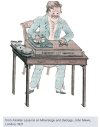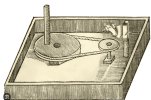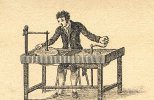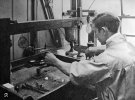When I worked in the Jewellery Quarter there was a chap at our place who worked a few days each week as a polisher/lapper. He was an old boy named Bill with one good eye, an arthritic gate and a fag (seemingly) permanently in his mouth. He would sit for hours, absolutely motionless apart from his right arm, perched on a high stool at a lap wheel. I would marvel at the fact that the ash from his cigarette would remain unbroken for a remarkable length of time, at least half the length of it. One of the company’s owners (a very well to do chap) would sometimes walk past and I once heard him say “Morning Bill, still not dead yet?” to which Bill replied “Morning Martin! followed by *&##@&*£% *$\£!$!! under his breath.
The main business of the company was producing signet rings, though it also made earrings, bracelets, medallions and carried out repairs. For those who may be interested I’ll describe how the rings were produced as well as I can remember but please take into account I’m going back nearly 40 years.
Sheet gold or silver was placed in a fly press (a hand operated press where pulling a large, weighted handle would force a tool downwards) and cut out something that vaguely resembled a champion boxer’s belt. A bit like a cookie cutter, so to speak. These “blanks” were then placed into a hydraulic press where the final design of the ring was embossed into it at great pressure and the excess was cut off. What was left resembled something that looked like a wristwatch with its strap undone, laid flat out. The next step was to anneal (soften) the metal to make it more malleable, this was done simply by placing these pressings on a “boss” (a square of flame proof material with a handle on the back) and heating them with a gas torch until they glowed red, then leaving them to cool.
The next step was to cut the rings to size, A, B, C etc. Of course, the circumference of a circle (ring) is easily determined but because each ring variety varied (shape, thickness, design, material etc) they had to be cut to a certain length to eventually reach a specific size. Therefore, each ring design had a code and the correct length to cut them could be found in a little book kept on your bench (often referred to as a “Peg” from the small piece of wood you rested your work on as you shaped and filed it.) So if you were producing say, 100 rings, you may have 20 at size F, 20 at size G etc and you’d cut accordingly.
Next, you’d file the ends of each piece square and then file a chamfer (sloping edge) to them, this would allow the gold or silver solder to easily enter the joint. A 1/2” piece of steel tubing was placed in the jaws of a small set of smooth faced pliers and the ends of each piece was bent around it until the ends met. When these were all done, the joint of each ring was dipped in a mixture of alcohol and boracic acid (a flux) then gold or silver soldered using the gas torch fixed at every jeweller’s bench.
The next step was to hammer the rings to the correct size. Each one was placed on a sold steel triblet (you’ve probably seen hollow versions in jewellery stores) which is a long, tapering bar with sizes marked along it at intervals. The tip of this was placed on, believe it of not, a length of tree trunk about 2-3 foot long, stood on end. The tip would rest in one of the may grooves worn into it over the years, and using a mallet with a head made from rolled animal hide, you would beat the shank of the ring as you rotated the triblet, carefully avoiding the head if it were hollow in particular. Eventually, the ring would stretch to the desired size. I will tell you now that if you had to make a couple of hundred heavy silver rings in one go you damn well earned your money, and if 3 or 4 blokes were hammering away at the same time in the same little room there was a right racket! (Mind you, the noise was nothing compared to the forge I later worked in but that’s another story.)
The correct size attained, each ring was placed on a steel block and the shank was straightened with a small hammer. Then using a pair of smooth faced pliers, each ring in turn was placed on your peg at your bench and you filed everything smooth and to the correct shape. All this having been done you would then, using various grades of emery cloth attached to a spindle or felt wheel mounted to a fixed electric motor, further smooth and shape the rings inside and out. These were then put on a loop of copper wire and placed in a hot bath (I think it was made of lead) of some form of acid, probably hydrochloric. After this, they were placed in a long, hexagonal barrel with a cleaning solution and if I recall correctly, steel shot. This barrel would then rotate for hours, which was the first element of the polishing process. Removed from the barrel, they were then polished using various rotary mops and waxes (rouge) and finally placed in a hot, ultrasonic bath to clean them. One final inspection and the work was done.
I enjoyed working in the Jewellery Quarter as a young man and was sad to leave it but unfortunately it was piece work and come January, when nobody was buying jewellery, the wages were terrible so I had to move on.






